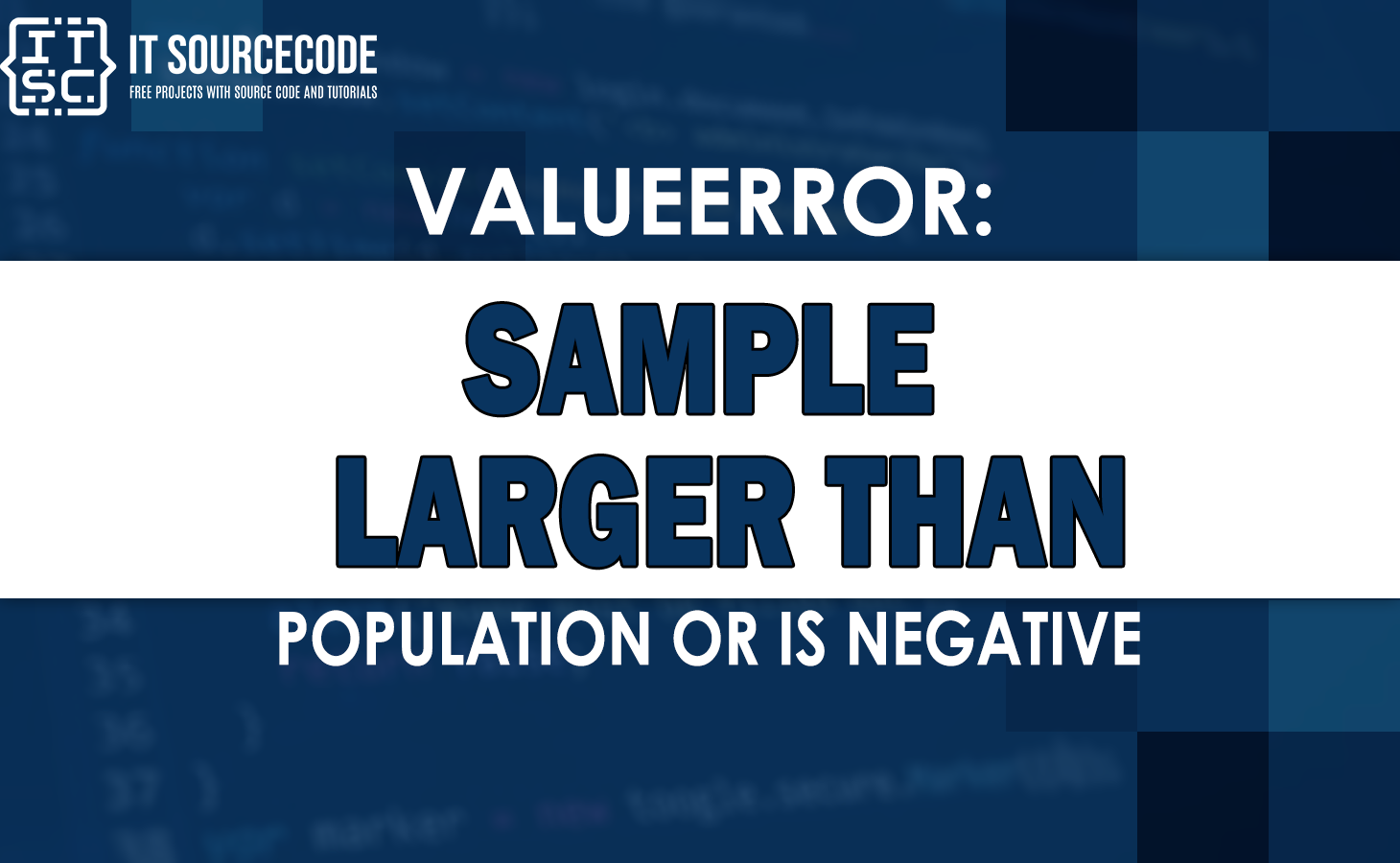This Valueerror: sample larger than population or is negative error typically occurs when working with samples and populations, and it shown that the sample size provided is either larger than the population or negative.
Understanding the ValueError
The ValueError: Sample Larger Than Population or is Negative is an error that occurs when attempting to perform sampling operations on data sets.
This error shown that the sample size we are attempting to obtain is larger than the population itself or that you are dealing with negative values, which is not permitted in the context of sampling.
Common Causes of the ValueError
Here are the following common possible causes of valueerror:
- Incorrect Sample Size
- Negative Sample Size
How to Solve the Valueerror sample larger than population or is negative?
In this section, we will provide you the example codes and solutions to fix the ValueError Sample larger than population or is negative error.
By applying these solutions, you can effectively handle the value error and ensure smooth execution of your Python programs.
Solution 1: Checking the Sample Size
To avoid the ValueError related to a sample size larger than the population, you can add a check to ensure that the sample size is within the acceptable range.
Here’s an example code:
example_population = [1, 2, 3, 4, 5]
sample_variable = [6, 7, 8, 9, 10]
if len(sample) > len(population):
raise ValueError("Sample size cannot be larger than population size.")
else:
# Continue with your code
# ...
import random
# Randomly select elements from the population to form a sample
example_random_sample = random.sample(example_population, len(sample_variable))
print("Random Sample:", example_random_sample)
In this code, we compare the lengths of the example_population and sample_variable lists. If the sample_variable size exceeds the example_population size, we raise a ValueError with an appropriate error message.
Otherwise, you can proceed with the rest of your code.
Solution 2: Check the Population Size
In some scenarios, the valueerror may occur due to an incorrect population size.
To resolve this, you can check and adjust the population size to ensure it aligns with your requirements.
For example:
example_population_variable = [1, 2, 3, 4, 5]
sample_value = [6, 7, 8, 9, 10]
if len(sample_value) > len(example_population_variable):
example_population_variable.extend([0] * (len(sample_value) - len(example_population_variable)))
for i in range(len(example_population_variable)):
example_population_variable[i] += sample_value[i]
print(example_population_variable)Output:
[7, 9, 11, 13, 15]
Solution 3: Handling Negative Values in the Sample
To handle the situation where the sample size is negative, you can use a conditional statement to check for this condition.
Here’s an example code:
example_variable_size = -10
if example_variable_size < 0:
raise ValueError("Sample size cannot be negative.")
else:
# Continue with your code
# ...
print("Sample size is valid. Proceeding with the rest of the code.")
# ...In this example code, an initial value of example_variable_size is set to -10.
The code then checks if the example_variable_size is less than 0 using an if statement.
If it is indeed less than 0, a ValueError is raised with the message “Sample size cannot be negative”.
This exception is used to handle cases where an invalid sample size is provided.
Solution 4: Implementing Data Validation Techniques
To avoid the ValueError: Sample larger than population or is negative error from occurring, you can apply data validation techniques to ensure the integrity of your inputs.
This involves validating the sample and population sizes before performing any operations on them.
Here’s an example:
import statistics
def perform_example_analysis(population_example, sample_value):
if len(sample_value) > len(population_example):
raise ValueError("Sample size cannot be larger than population size.")
elif len(sample_value) < 0:
raise ValueError("Sample size cannot be negative.")
else:
# Continue with your analysis
population_mean = statistics.mean(population_example)
sample_mean = statistics.mean(sample_value)
population_stddev = statistics.stdev(population_example)
sample_stddev = statistics.stdev(sample_value)
print("Population mean:", population_mean)
print("Sample mean:", sample_mean)
print("Population standard deviation:", population_stddev)
print("Sample standard deviation:", sample_stddev)
# Continue with additional analysis or calculations
# ...
population_example = [1, 2, 3, 4, 5]
sample_value = [6, 7, 8, 9, 10]
perform_example_analysis(population_example, sample_value)Output:
Population mean: 3
Sample mean: 8
Population standard deviation: 1.5811388300841898
Sample standard deviation: 1.5811388300841898
In example code provided, the perform_example_analysis function calculates the mean and standard deviation of both the population example and the sample value.
It uses the statistics.mean and statistics.stdev functions from the Python statistics module for this purpose.
FAQs
The ValueError Sample larger than population or is negative error shown that the sample size provided is either larger than the population size or negative.
You may encounter the ValueError Sample larger than population or is negative error when the sample size provided in your code is larger than the population size or negative.
Conclusion
In conclusion, the ValueError: Sample larger than population or is negative error can be resolved by understanding its causes and applying a proper coding solutions.

